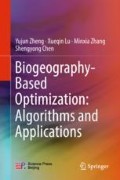Abstract
Artificial neural networks (ANNs) have powerful function approximation and pattern classification capabilities, but their performance is greatly affected by structural design and parameter selection. This chapter introduces how to use BBO and its variants for optimizing structures and parameters of ANNs. The results show that BBO is a powerful method for enhancing the performance of many machine learning models.
Access this chapter
Tax calculation will be finalised at checkout
Purchases are for personal use only
References
Blake CL, Merz CJ (1998) UCI repository of machine learning databases. http://www.ics.uci.edu/~mlearn/MLRepository.html
David OE, Greental I (2014) Genetic algorithms for evolving deep neural networks. In: Proceedings of the GECCO, pp 1451–1452. https://doi.org/10.1145/2598394.2602287
Hinton GE (1989) Connectionist learning procedures. Artif Intell 40(1):185–234. https://doi.org/10.1016/0004-3702(89)90049-0
Hinton GE, Salakhutdinov RR (2006) Reducing the dimensionality of data with neural networks. Science 313(5786):504–507
Hopfield JJ (1982) Neural networks and physical systems with emergent collective computational abilities. Proc Nat Acad Sci 79:2554–2558. https://doi.org/10.1073/pnas.79.8.2554
Juang CF, Hsiao CM, Hsu CH (2010) Hierarchical cluster-based multispecies particle-swarm optimization for fuzzy-system optimization. IEEE Trans Fuzzy Syst 18:14–26. https://doi.org/10.1109/TFUZZ.2009.2034529
Lee H, Grosse R, Ranganath R, Ng AY (2009) Convolutional deep belief networks for scalable unsupervised learning of hierarchical representations. In: Proceedings of the 26th annual international conference on machine learning, pp 609–616. https://doi.org/10.1145/1553374.1553453
Leung FHF, Lam HK, Ling SH, Tam PKS (2003) Tuning of the structure and parameters of a neural network using an improved genetic algorithm. IEEE Trans Neural Netw 14:79–88. https://doi.org/10.1109/TNN.2002.804317
Liang JJ, Qin AK, Suganthan P, Baskar S (2006) Comprehensive learning particle swarm optimizer for global optimization of multimodal functions. IEEE Trans Evol Comput 10:281–295. https://doi.org/10.1109/TEVC.2005.857610
Lin CT (1996) Neural fuzzy systems: a neuro-fuzzy synergism to intelligent systems. Prentice Hall PTR, Upper Saddle River
Ma H, Simon D (2011) Blended biogeography-based optimization for constrained optimization. Eng Appl Artif Int 24:517–525. https://doi.org/10.1016/j.engappai.2010.08.005
McCulloch WS, Pitts WH (1943) A logical calculus for the ideas immanent in nervous activity. Bull Math Biophys 5:115–133. https://doi.org/10.1007/BF0247825
Negnevitsky M (2005) Artificial intelligence: a guide to intelligent systems. Pearson Education, Essex (2005)
ao Paulo Papa J, Scheirer W, Cox DD (2016) Fine-tuning deep belief networks using harmony search. Appl Soft Comput 46:875–885. https://doi.org/10.1016/j.asoc.2015.08.043
Qin AK, Huang VL, Suganthan P (2009) Differential evolution algorithm with strategy adaptation for global numerical optimization. IEEE Trans Evol Comput 13:398–417. https://doi.org/10.1109/TEVC.2008.927706
Simon D (2008) Biogeography-based optimization. IEEE Trans Evol Comput 12:702–713. https://doi.org/10.1109/TEVC.2008.919004
Song Q, Zheng YJ, Xue Y, Sheng WG, Zhao MR (2017) An evolutionary deep neural network for predicting morbidity of gastrointestinal infections by food contamination. Neurocomputing 226:16–22. https://doi.org/10.1016/j.neucom.2016.11.018
Vincent P, Larochelle H, Bengio Y, Manzagol PA (2008) Extracting and composing robust features with denoising autoencoders. In: Proceedings of the 25th international conference on machine learning, pp 1096–1103. ACM, New York, NY, USA. https://doi.org/10.1145/1390156.1390294
Vincent P, Larochelle H, Lajoie I, Bengio Y, Manzagol PA (2010) Stacked denoising autoencoders: learning useful representations in a deep network with a local denoising criterion. J Mach Learn Res 11:3371–3408
Wu GD, Zhu ZW, Huang PH (2011) A TS-type maximizing-discriminability-based recurrent fuzzy network for classification problems. IEEE Trans Fuzzy Syst 19:339–352. https://doi.org/10.1109/TFUZZ.2010.2098879
Zhang JR, Zhang J, Lok TM, Lyu MR (2007) A hybrid particle swarm optimization-back-propagation algorithm for feedforward neural network training. Appl Math Comput 185:1026–1037. https://doi.org/10.1016/j.amc.2006.07.025
Zheng YJ, Ling HF, Wu XB, Xue JY (2014) Localized biogeography-based optimization. Soft Comput 18:2323–2334. https://doi.org/10.1007/s00500-013-1209-1
Zheng YJ, Ling HF, Xue JY (2014) Ecogeography-based optimization: enhancing biogeography-based optimization with ecogeographic barriers and differentiations. Comput Oper Res 50:115–127. https://doi.org/10.1016/j.cor.2014.04.013
Zheng YJ, Ling HF, Chen SY, Xue JY (2015) A hybrid neuro-fuzzy network based on differential biogeography-based optimization for online population classification in earthquakes. IEEE Trans Fuzzy Syst 23:1070–1083. https://doi.org/10.1109/TFUZZ.2014.2337938
Author information
Authors and Affiliations
Corresponding author
Rights and permissions
Copyright information
© 2019 Springer Nature Singapore Pte Ltd. and Science Press, Beijing
About this chapter
Cite this chapter
Zheng, Y., Lu, X., Zhang, M., Chen, S. (2019). Biogeography-Based Optimization in Machine Learning. In: Biogeography-Based Optimization: Algorithms and Applications. Springer, Singapore. https://doi.org/10.1007/978-981-13-2586-1_9
Download citation
DOI: https://doi.org/10.1007/978-981-13-2586-1_9
Published:
Publisher Name: Springer, Singapore
Print ISBN: 978-981-13-2585-4
Online ISBN: 978-981-13-2586-1
eBook Packages: Intelligent Technologies and RoboticsIntelligent Technologies and Robotics (R0)

